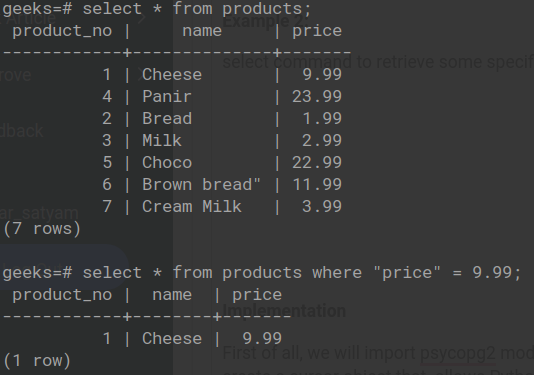En este artículo, vamos a ver cómo la cláusula Where en PostgreSQL usando Psycopg2 en Python.
Las Cláusulas Where nos ayudan a manejar fácilmente las bases de datos. Como sabemos, tenemos una gran cantidad de datos almacenados en nuestra base de datos, por lo que es útil extraer solo las cláusulas de información útil y requerida. La cláusula WHERE se usa para extraer solo aquellos registros que cumplen una condición requerida.
Sintaxis: SELECT columna1, columna2, ….. FROM table_name WHERE condición
Demostración de tabla con cláusula where:

Ejemplo: Al principio, aquí hemos mostrado cómo crear una tabla y luego insertar valores en ella.
Python3
import psycopg2
# establishing the connection
conn = psycopg2.connect(
database="test",
user='postgres',
password='password',
host='localhost',
port='5432'
)
# Creating a cursor object using the cursor() method
cursor = conn.cursor()
sql = '''CREATE TABLE WORKER(
ID BIGSERIAL NOT NULL PRIMARY KEY,
NAME VARCHAR(100) NOT NULL,
COUNTRY VARCHAR(50) NOT NULL,
AGE INT,
SALARY FLOAT
)'''
cursor.execute(sql)
# Inserting values into the table
insert_stmt = "INSERT INTO WORKER (NAME, COUNTRY, AGE, SALARY) \
VALUES (%s, %s, %s, %s)"
data = [('Krishna', 'India', 19, 2000),
('Harry', 'USA', 20, 7000),
('Malang', 'Nepal', 25, 5000),
('Apple', 'London', 26, 2000),
('Vishnu', 'India', 29, 2000),
('Frank', 'UAE', 21, 7000),
('Master', 'USA', 25, 5000),
('Montu', 'India', 26, 2000),
]
cursor.executemany(insert_stmt, data)
# Retrieving specific records using the where clause
cursor.execute("SELECT * from WORKER WHERE AGE <23")
print(cursor.fetchall())
# Retrieving specific records using the where clause
cursor.execute("SELECT * from WORKER WHERE COUNTRY='India' ")
print(cursor.fetchall())
# Retrieving name of employees whose salary is 5000
cursor.execute("SELECT name from WORKER WHERE salary=5000 ")
print(cursor.fetchall())
# Retrieving name and country of employees whose salary is 2000
cursor.execute("SELECT name, country from WORKER WHERE salary=2000 ")
print(cursor.fetchall())
# Commit your changes in the database
conn.commit()
# Closing the connection
conn.close()
Producción:

cláusula where usando pyscopg2 en Python
Publicación traducida automáticamente
Artículo escrito por kumaribabita2402 y traducido por Barcelona Geeks. The original can be accessed here. Licence: CCBY-SA